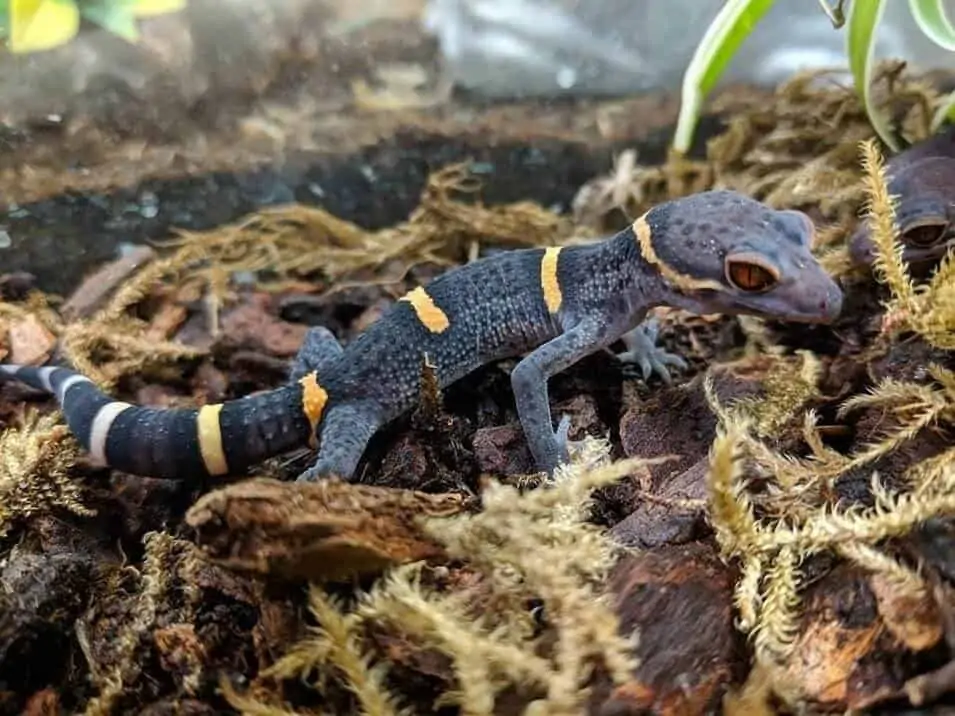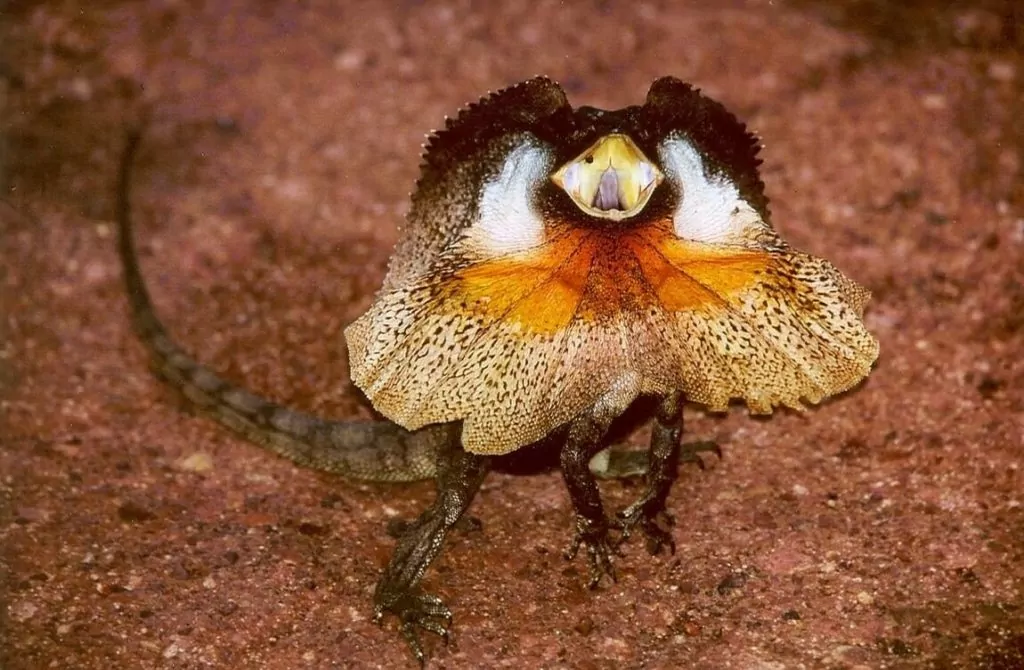Knowing the best plants for chameleons is essential if you’re trying to set up the perfect enclosure. But with so many species out there, it can be hard to figure out which ones to try!
Fortunately, this list makes it easy.
The Best Plants For Chameleons
Choosing the right plants for chameleons is essential if you want to construct the perfect habitat for your pet reptile. These lizards rely on plants for shelter, comfort, and even hydration. They also keep the air humid and create an environment conducive to the lifestyle of these animals.
The more lush and plant-filled a chameleon habitat is, the better! Here are some of the best plants for chameleons to get you started.
1. Petunias
Petunias are beautiful flowering plants that can add tons of color to your chameleon’s enclosure. The plant is smaller, so it will act more like ground cover. It’s a member of the nightshade family, but it lacks extreme toxicity. As a result, it’s safe for your lizard.
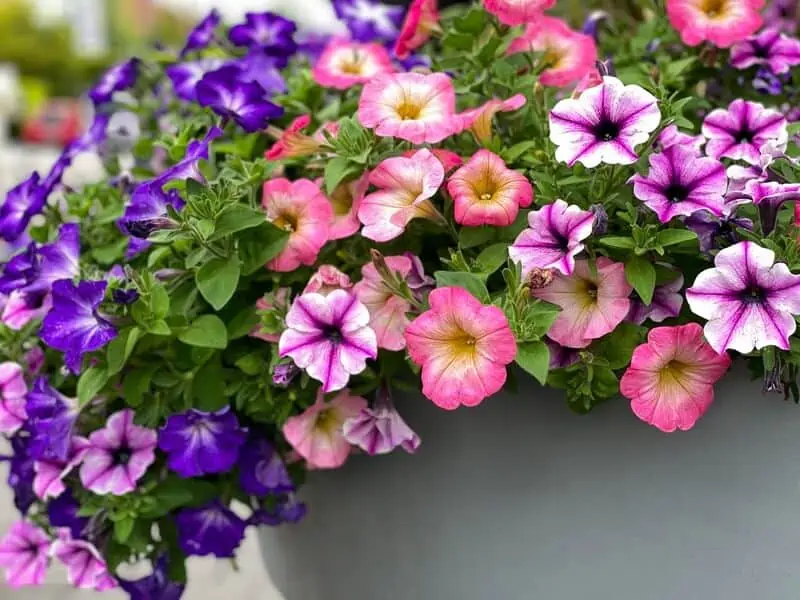
This plant requires soil with decent drainage. It’s best to water it every other day or whenever the soil becomes dry. Give it a reptile-safe fertilizer once a month, and it should grow nicely.
Technically, petunias need direct sunlight. However, that’s not always possible in an enclosed tank. But one of the reasons why they’re such good plants for chameleons is that the flowers will still bloom even without direct sun. They’ll just bloom slower.
2. Ficus Benjamina
The Ficus benjamina is one of the more popular plants for chameleons, and it’s not hard to see why. These plants are leafy, providing tons of coverage and creating a lush look.
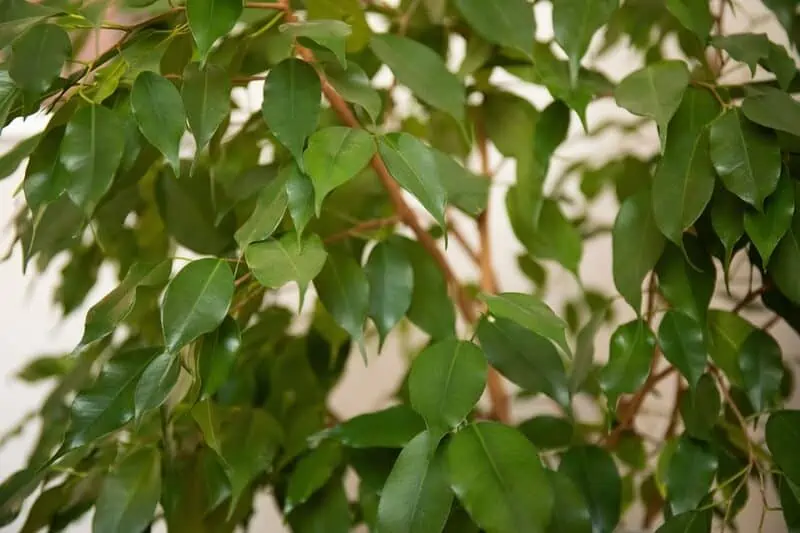
However, they also have sturdy stems that chameleons can climb on.
Caring for the Ficus benjamina can be challenging. It’s prone to rot if the soil doesn’t drain quickly. You can also deprive it of hydration if you don’t stick to a consistent watering schedule.
Ideally, this plant will get water when the soil is dry to about three centimeters. It can also do well with weekly feedings of plant fertilizer. Make sure to give the plant ample access to the sun. Otherwise, it’ll drop its leaves.
In the same conversation, you might hear seasoned reptile keepers talking about Weeping Figs and Ficus Benjamina. That’s because the plants are the same! Ficus Benjamina is the plant’s scientific name, but its signature look earned it the Weeping Fig moniker as a trade name.
3. Japanese Aralia
Here’s a beautiful green plant that pushes the lush vibes of a carefully decorated chameleon exposure. The Japanese aralia has large green leaves and does well in the same growing conditions as a chameleon’s habitat. The plant is also hardy and relatively easy to grow.
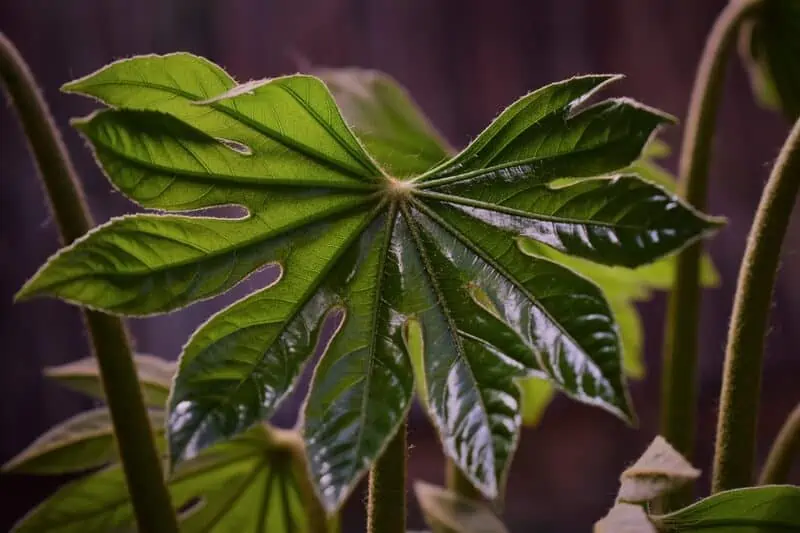
You don’t need to be a seasoned gardener to help the Japanese aralia thrive. It’s unfussy about soil conditions, allowing you to cater the enclosure to pickier plants. You can also put it just about anywhere in the habitat thanks to its low-light adaptability. Water the plant whenever it starts to look dry, and offer some liquid fertilizer every ten days during the spring and fall to help the plant look its best
4. Corn Plant
The corn plant is aptly named for its unique shape. It has a thick, climbable trunk and a burst of thin leaves up top like a corn stalk. If you’re not the best at keeping plants alive, this cultivar is worth trying!
It’s a relatively hands-off option. Not only does it not require frequent watering, but it adapts well to the indirect sunlight of a reptile enclosure. Pair that with its one-a-year fertilizer needs; this is a great plant for chameleons that you won’t have to worry about too much.
5. Bromeliad
The bromeliad is one of the more recognizable blooming plants in the pet trade. It’s a signature tropical plant with conditions that perfectly match a chameleon’s habitat. It’s colorful, provides wonderful visual appeal, and offers a decent amount of coverage to make your lizard feel safe.
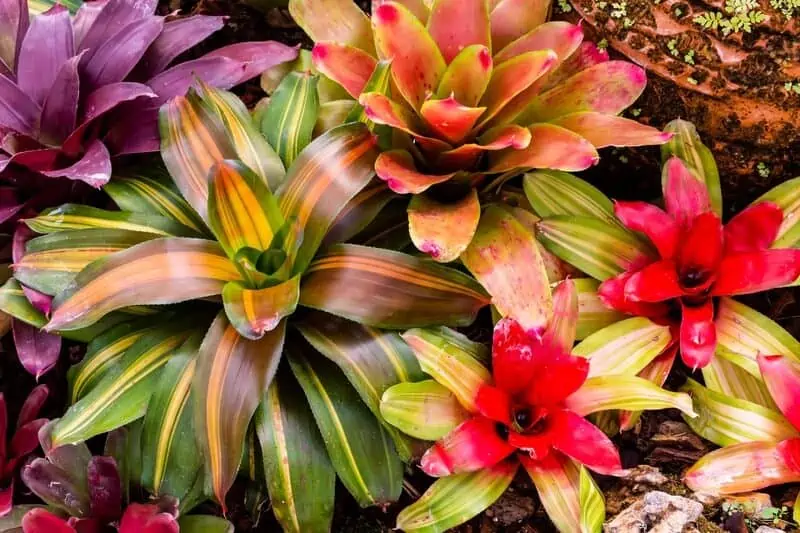
In terms of care, bromeliad plants don’t need much. They prefer a fast-draining soil of peat moss and sand. Once-a-week watering is all this plant needs. Don’t overdo the water, as standing moisture could lead to root rot!
The bromeliad prefers indirect bright light. Plenty of access to the enclosure lights is a must!
6. Parlor Palm
The parlor palm isn’t the best plant for chameleons when it comes to climbability, but its thin leaves and lush foliage make it an excellent choice for coverage. Many reptile keepers use this plant to pack a significant visual punch. It easily covers an enclosure, making it easy to create a jungle-like setting.
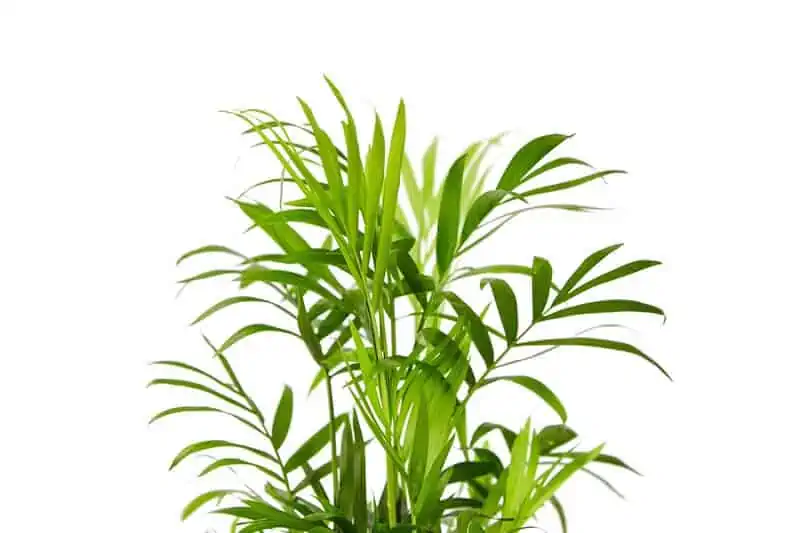
The best part? The parlor palm is a leafy plant that does a fine job of capturing water droplets that your chameleon will lap up.
Low light is best for the parlor palm. It uses standard potting soil and prefers to have evenly moist ground to sit in.
7. Rubber Tree
The rubber plant makes an excellent addition to a chameleon enclosure for many reasons. Its large, waxy leaves collect water for drinking, and the sturdy trunk is suitable for climbing. These plants can grow very large but stay at manageable heights in captivity.
To keep the rubber plant healthy, you’ll need to keep it in a high-aggregate mix of sand, soil, and mulch. Wait to water the plant until the soil is almost dry, and provide a standard houseplant fertilizer every two weeks. For light, indirect light is ideal. Please keep it away from heat lamps to avoid any health issues.
8. Jade Plant
Jade plants have thick, fleshy leaves. It’s a succulent plant with a unique look. Its unique leaves grow quickly, and blooms can create stunning pops of color if the conditions are right. Despite looking delicate, it’s a great plant for chameleons because its stems are sturdy enough for them to navigate.
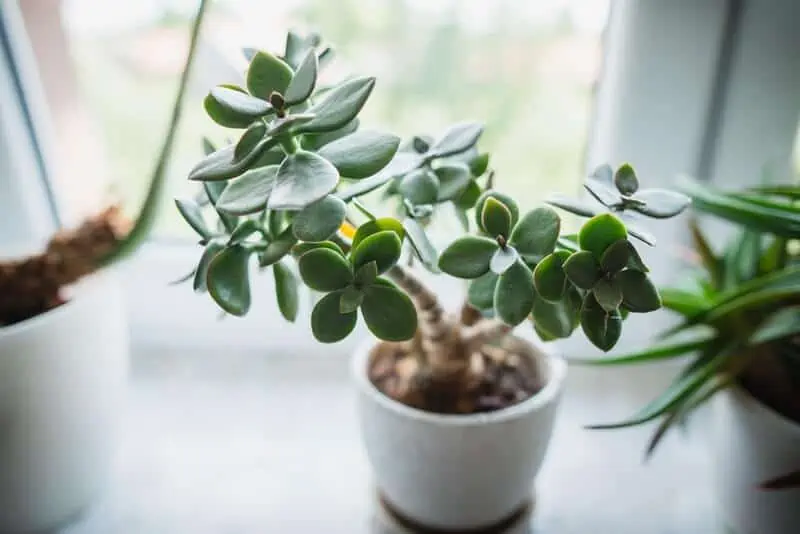
This plant’s most challenging need is light. It needs several hours of direct sunlight. Many reptile enthusiasts will keep their enclosures near a sunny window or install a reliable UV light system to keep the jade plant healthy.
Thankfully, the water requirements aren’t so demanding. It’s a succulent, so it does well with infrequent watering.
9. Ti Plant
Here’s a bushy plant that looks beautiful in chameleon habitats. It’s a low-growing bush with broad, waxy leaves. The leaves are wonderful for catching water and providing coverage for your chameleon.
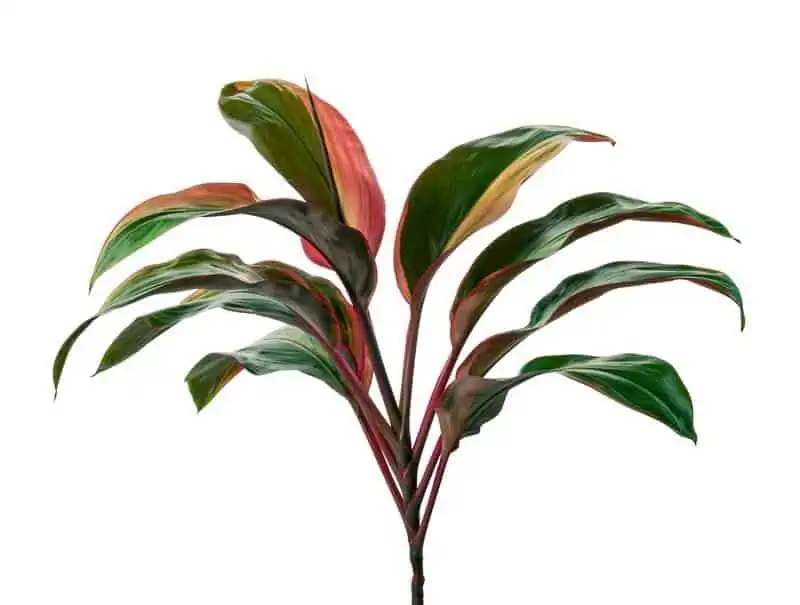
The color is nothing short of stunning—shades of dark brown and vibrant pink offer a nice contrast to the typical green of tropical plants.
Bark-based soil is best for the ti plant. Indirect light and bi-weekly fertilization during the Spring and Fall are all this plant needs. In terms of watering, the ti plant’s soil should stay moist. It’ll do wonders to maintain humidity levels in your chameleon’s enclosure.
10. Easter Cactus
Here’s another succulent worth checking out. The Easter cactus has fleshy leaves that are perfect for catching water. Don’t worry: There are no spikes to impale your chameleon!
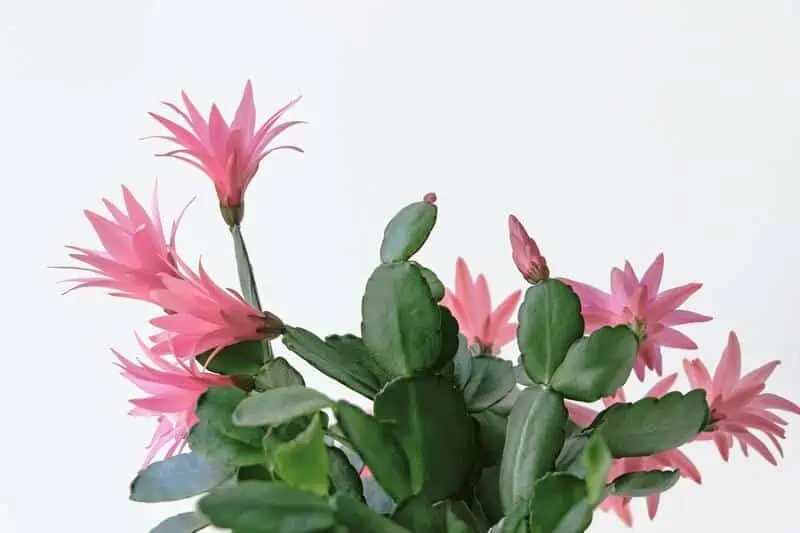
You will, however, see beautiful pink blooms around Easter time!
The Easter cactus is ideal for chameleon enclosures because it needs darkness to thrive. It also lights bright light, but it’ll benefit from the dark nighttime hours of your habitat.
The plant does best in organic soil and only requires as much watering to stay moist.
11. Passion Flower
The passion flower plant is a fast-growing beauty that will produce tendrils of vines in all directions! The vines are fantastic for climbing, and the fast proliferation adds a lot of life to your reptile enclosure. It does require frequent pruning, but that’s a tradeoff most enthusiasts don’t mind.
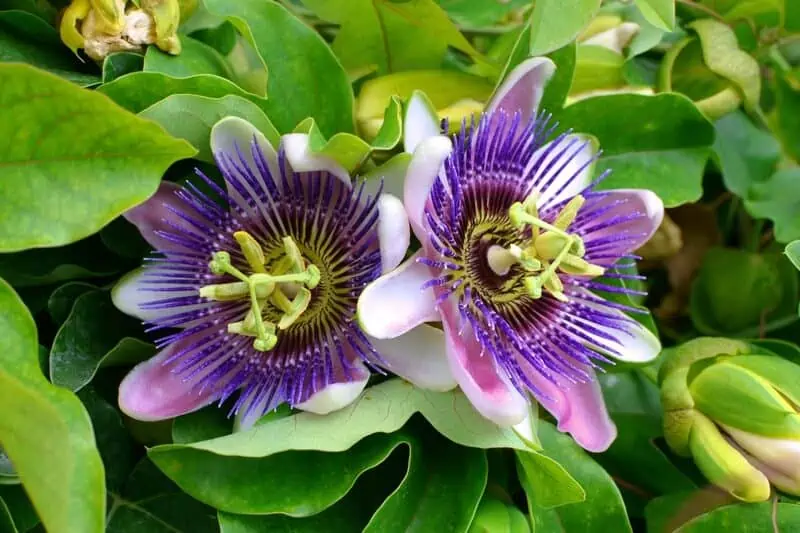
The most impressive thing about the plant is the blooms. Passion flowers are nothing short of beautiful, and they can certainly spruce up any habitat.
These plants need fast-draining soil and daily watering to stay healthy. Once-a-week fertilizer and intense light exposure are essential, too.
12. Golden Pothos
Also known as the devil’s ivy, golden pothos is a hanging plant that produces gorgeous trailing vines. It creates many opportunities for climbing, and the foliage offers good coverage to make your reptile feel safe. Interestingly, many chameleons also enjoy snacking on golden pothos leaves.
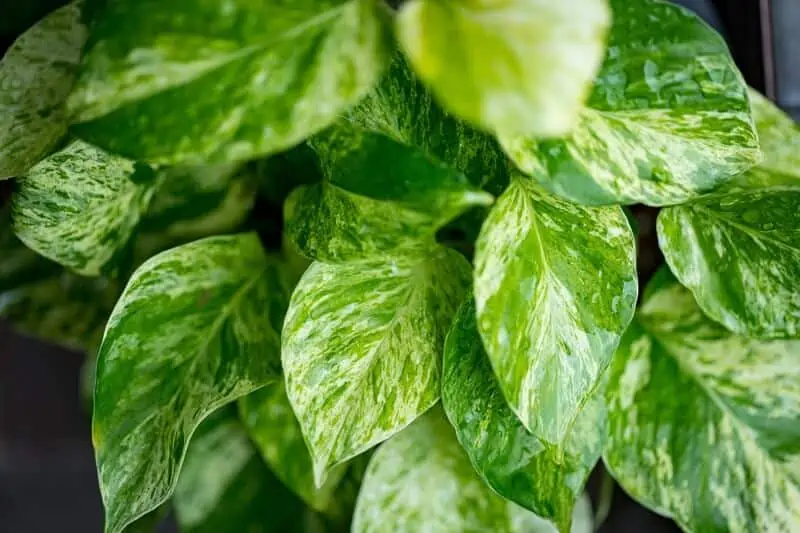
This is one of the best plants for chameleons because caring for it is relatively straightforward. It links direct light, but it can tolerate low-light conditions. It needs soil that drains efficiently and only requires watering when the leaves start to droop. Round those care guidelines with once-a-month fertilizing, and you’re good to go.
13. Jasmine
Who doesn’t love a fragrant jasmine plant? This plant is a unique addition to reptile enclosures. It’s a solid climber that produces lush leaves and aromatic flowers.
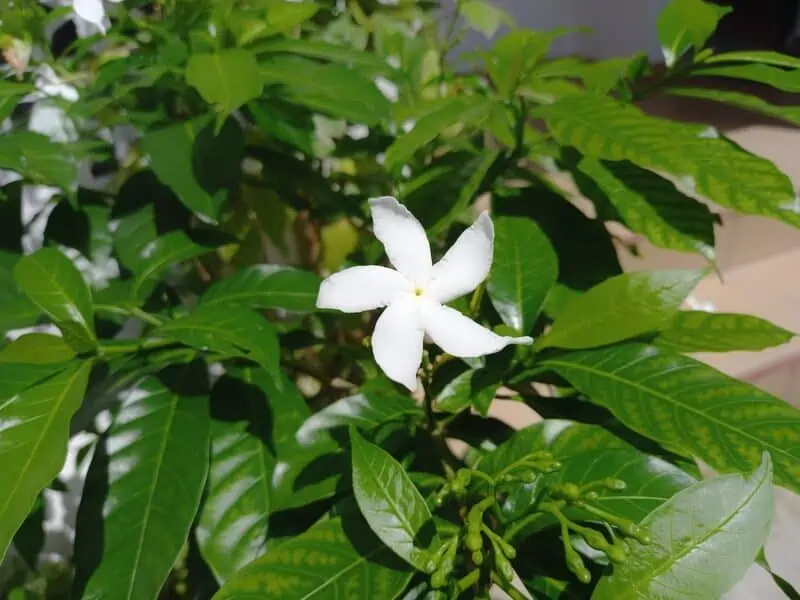
Jasmine plants need organic potting soil with bark and peat to thrive in a chameleon enclosure. It should drain well enough to accommodate regular watering that keeps things moist.
For light exposure, jasmine prefers indirect light. It only requires fertilizer every few weeks during Spring and Summer.
14. Hibiscus
Hibiscus can be a challenge to grow. But ask any chameleon owner, and they’ll tell you that learning how to cultivate these plants is worth it.
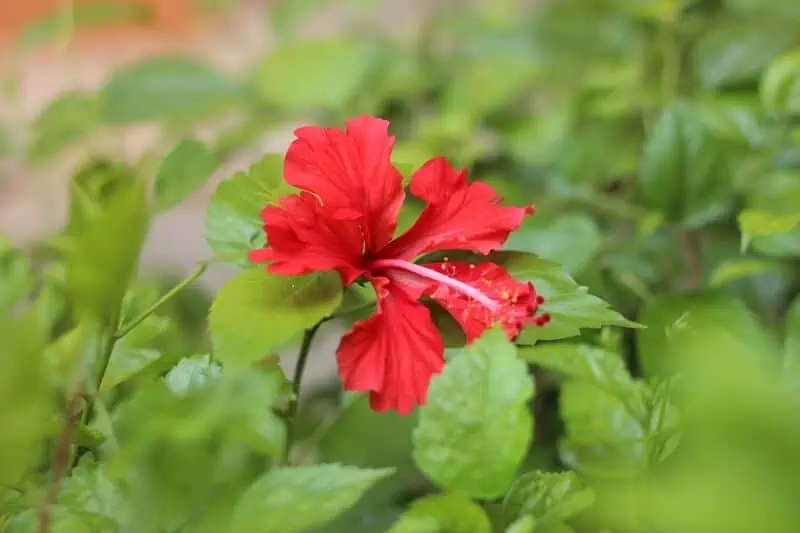
Chameleons love to eat the hibiscus flower. This plant isn’t just safe for them, it’s an excellent source of Vitamin C! So having a supply of it in the enclosure can do wonders for your reptile’s health.
For soil, a fast-draining potting mix is ideal. This plant requires thorough watering, and it’s best to wait until the top inch of soil dries between watering. Hibiscus needs direct light. It’s a good idea to move the plant outside during the growing season or use strong UV lamps.
15. Schefflera Tree
The Schefflera tree is a beautiful tropical plant that thrives in climates like the one your chameleon needs to stay healthy. It grows tall, adding verticality to the enclosure and giving your reptile plenty of climbing opportunities. The unique umbrella-like leaves are beautiful, too, serving to collect water for hydration.
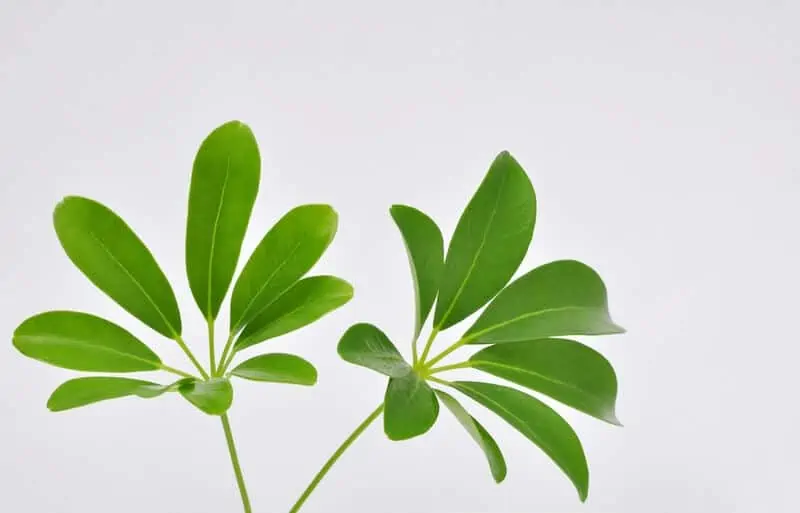
This plant likes soil that’s loosely packed. It needs to drain efficiently because the Schefflera plant does best when you wait until the soil is dry before watering it. Bright yet indirect lighting is best, opening up many placement possibilities.
16. Yucca
The yucca plant is another good plant for chameleons. It’s a quintessential tropical cultivar that adds a lot of enrichment and beauty to enclosed habitats. Like the corn plant from earlier, yucca has a thick, climbable trunk and a burst of beautiful green foliage.
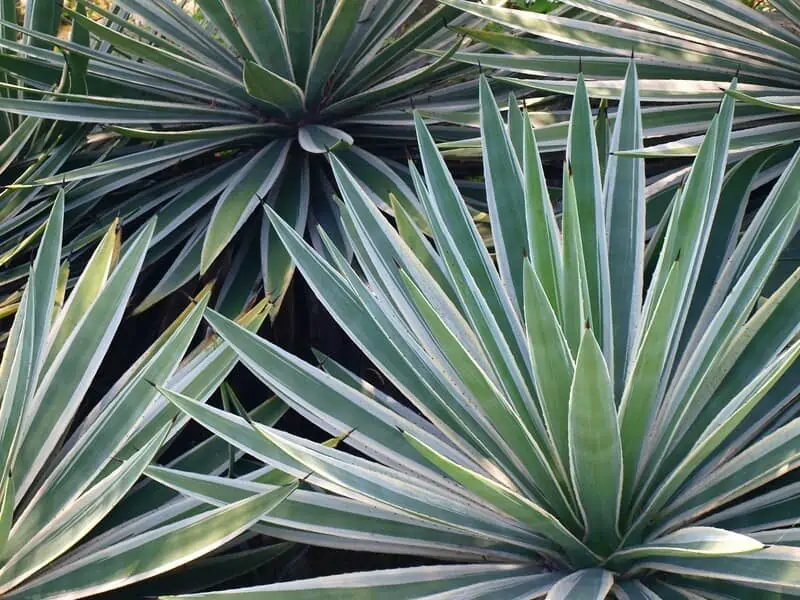
Fortunately, yucca plants aren’t overly demanding like others on this list. It only needs standard houseplant potting soil, light weekly watering, and partial lighting. Avoid putting the plant under heat lamps and offer occasional fertilizer feedings during the growing season.
Other than those basics, the yucca plant will thrive on its own. There’s no need for extensive pruning or care.
17. Swiss Cheese Plant
Such an odd name for a beautiful plant like this! Swiss cheese plants are fast-growing beauties with large, glossy leaves. The leaves provide expansive coverage, creating many surfaces that collect water your chameleon can lap up.
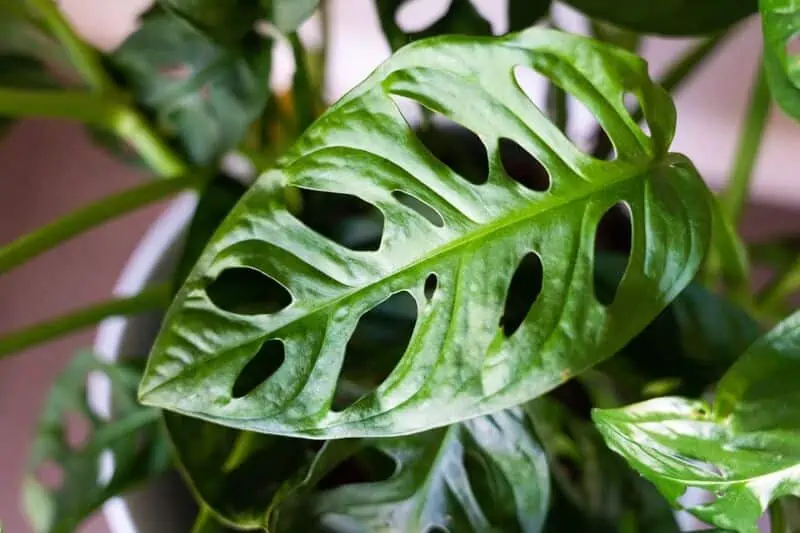
The swiss cheese plant enjoys organic soil with peat moss and good drainage. It is prone to root rot, so be mindful of your drainage setup. The plant also requires deep watering (which is something you should consider depending on the kind of chameleon you own). Luckily, it prefers that you wait until the top third of the soil is dry before watering it again.
Moderate lighting is ideal for the swiss cheese plant. In most cases, enclosure lights do just fine.
18. Spider Plant
The spider plant is a common houseplant that is also an excellent choice for chameleon habitats. The plant does very well in moderate to low lighting conditions, and it’s pretty easy to take care of, serving as a decent beginner-friendly option. The plant is a great choice for filling space.
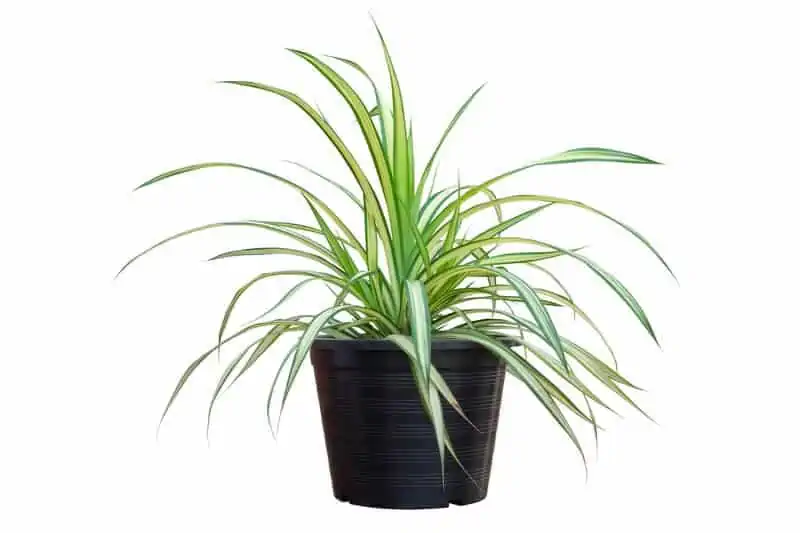
It doesn’t do much in terms of climb ability or coverage, but it can make your chameleon’s enclosure feel more authentic.
Standard houseplant soil is all you need for the spider plant. Regular watering to prevent drying is a must. However, it’s also crucial to avoid soggy soil and root rot!
For light, stick to indirect, low-intensity, or filtered light. Too much exposure and the leaves can go brown.
19. Areca Palm
Next up, we have the areca palm. It’s sometimes referred to as the butterfly palm thanks to its wispy leaves and delicate-looking plumage. The stems are tough enough for your chameleon to climb. They’re also densely packed, turning the plant into a little haven for hiding.
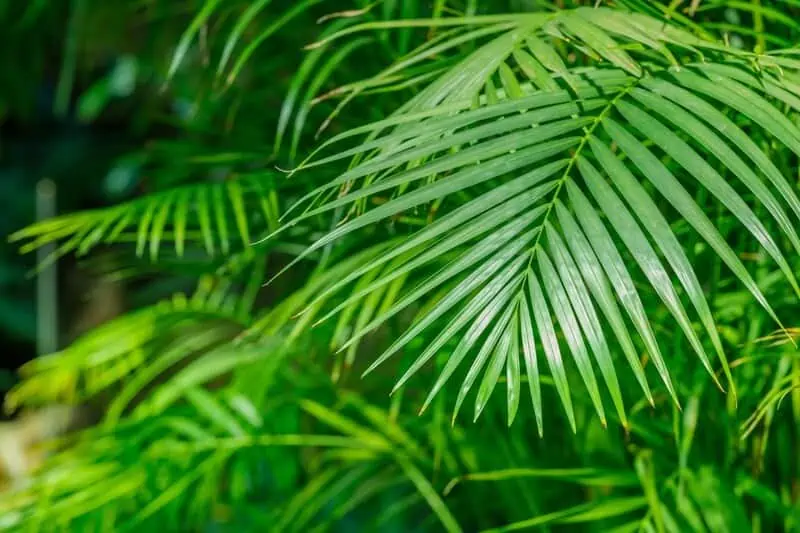
While it’s definitely one of the best plants for chameleons, it does have some more demanding care requirements. First, it needs bright light. Many enthusiasts will take the plant out to give it full sun a few times a week.
Regular watering is essential, but so is letting the soil dry out. The areca palm is sensitive to overwatering, so be mindful of the soil’s dryness.
20. Nasturtium
Check out this beauty! The nasturtium plant is a unique option for your chameleon enclosure. It has broad green leaves that offer plenty of coverage. The most visually appealing aspect of this plant is the vibrant red blooms! They create a nice pop of colorful contrast to the habitat.
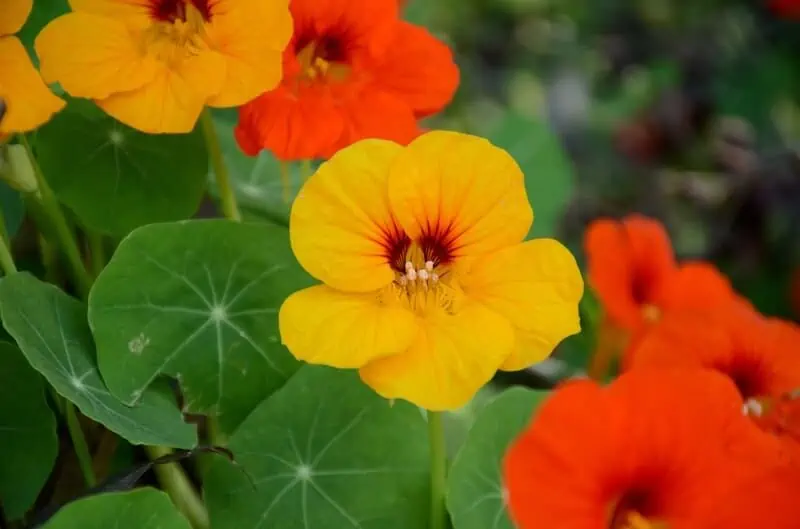
Another reason to consider nasturtium is to provide a healthy snack for your chameleon. They love nibbling on the plant’s leaves!
This plant prefers to have partial sunlight. That means installing UV lights in your enclosure or positioning the habitat next to a window. For water, nasturtiums require hydration once or twice a week. Overall, the soil should be somewhat damp at all times.
21. Dracaena Compacta
Also known as the “compact dragon tree,” this plant has a lot to offer. It’s a slow grower and doesn’t get very tall. However, those characteristics are all good things for a reptile enclosure.
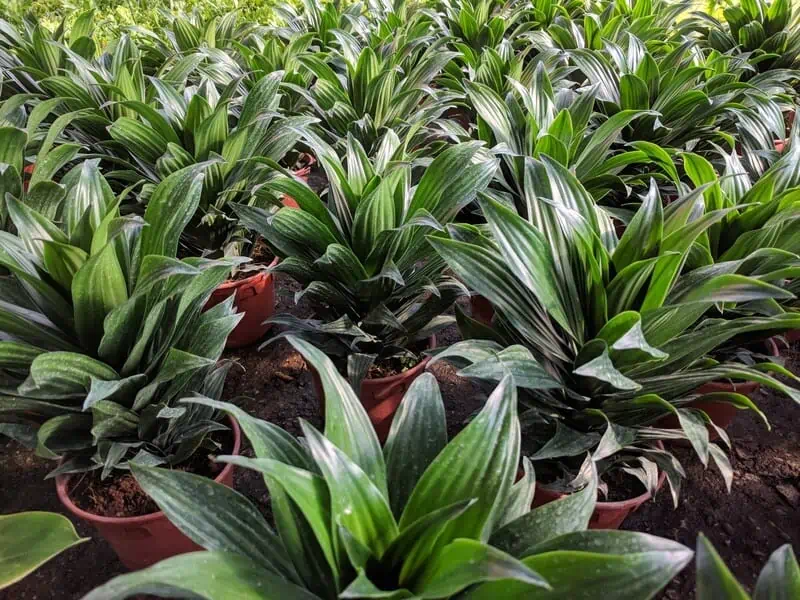
The Dracaena compacta develops sturdy trunks that can easily support a chameleon’s weight. Up top, waxy leaves collect water and provide all the coverage your lizard needs to feel safe.
This miniature tree requires good drainage. Overwatering is the quickest way to kill it! The soil should dry out before watering to prevent any issues.
The Dracaena compacta is shade tolerant but still needs a decent amount of UV light to stay healthy.
22. Wandering Jew
The wandering jew plant is a good choice if you want something to hang high up in the enclosure. It grows well in a hanging basket, producing tendrils of waxy leaves down your chameleon’s habitat.
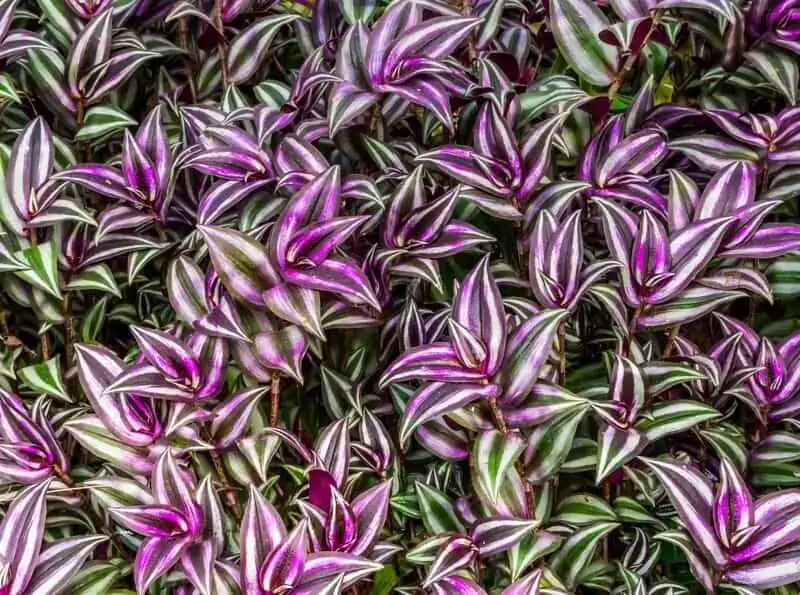
It’s ideal for coverage, but you can’t deny the aesthetics! Green striped leaves make up most of the wandering jew plant, but pops of the vibrant purple peak through to create something magical.
You don’t need to do much to keep this plant healthy. It thrives in standard house plant potting mix and requires weekly deep watering. It also does well with bi-monthly fertilization.
23. Geraniums
If colors and aesthetics are a top priority, this is definitely one of the best plants for chameleons. From a practical standpoint, geraniums fit the bill. They have large leaves for collecting water, and the density of the foliage is fantastic for creating little hiding spots chameleons can use to feel safe.
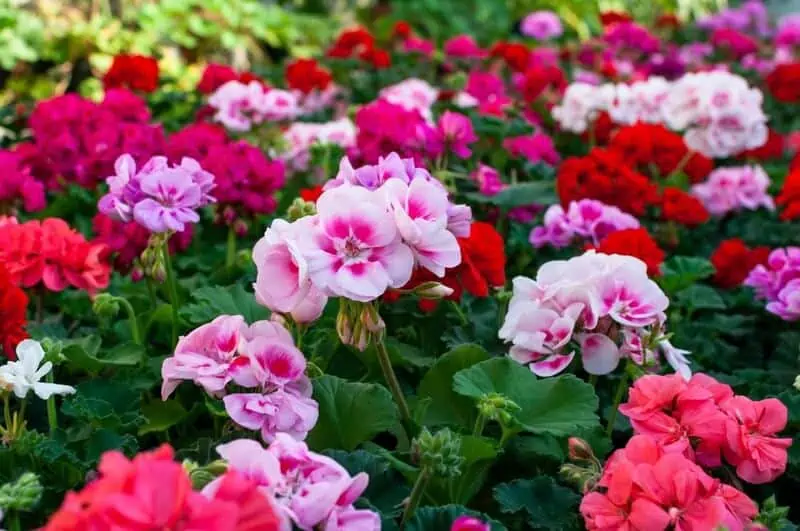
But where the geranium truly shines is its looks. Reddish-pink flowers create a stunning display you can’t help but appreciate.
Geraniums need organic potting soil with a penchant for good drainage to thrive. This plant is prone to waterlogging, so allow the soil to dry completely before rewatering.
You can place the plant anywhere on your chameleon enclosure floor. The indirect light is all it needs.
24. Gardenia
Gardenias offer a touch of class. The fragrant flowers look similar to other blooming plant cultivars, but the dense foliage makes it a good practical choice. The leaves offer coverage and do a fine job of collecting water. Meanwhile, the flowers bring a fantastic fragrance.
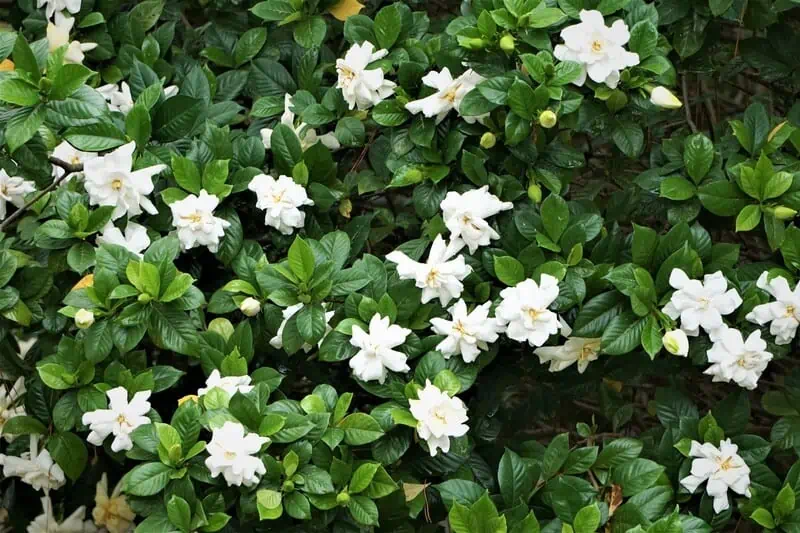
Gardenia plants do well in any potting soil that drains well. It prefers to stay in a moist environment, so don’t let the soil dry out too much between watering.
For light, indirect exposure is best. Pair that with the love of humidity, and it’s not hard to see why gardenias thrive in chameleon cages.
25. Wax Begonia
The wax begonia is an excellent choice for adorning the bottom and sides of your enclosure. The hardy plant grows up to two feet tall. It produces waxy leaves and flowers, creating a distinct look while offering ample coverage for your chameleon.
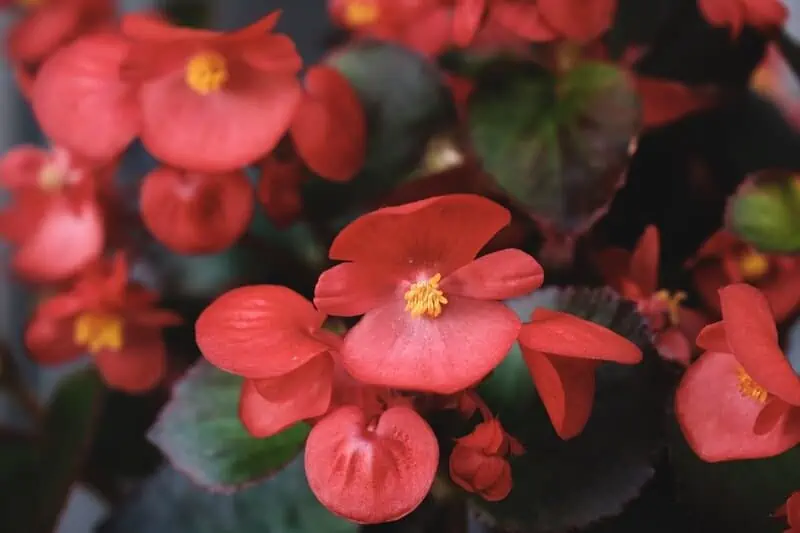
The flowering plant needs well-draining soil that remains moist. It doesn’t need constant watering. But you should check on it frequently to ensure that the environment is moist and humid.
To help this plant reach its full potential, give it plenty of exposure to bright light.
26. Grape Ivy
Want to add a trailing vine to your chameleon enclosure? Grape ivy is one of the best. It grows quickly and doesn’t require tons of attention like other plants.
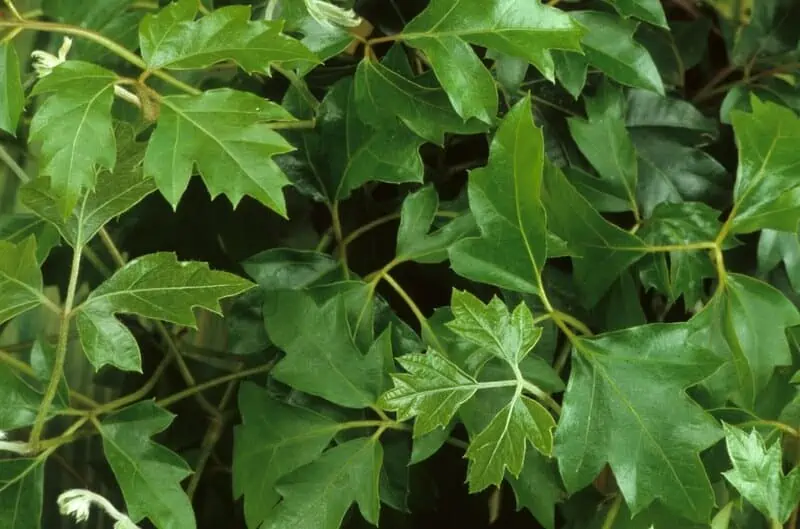
The vines aren’t exceptionally sturdy, so don’t be surprised if your chameleon never tries to climb them. However, the dense foliage makes up for that fact.
This plant thrives in hanging baskets with potting soil that drains well. It doesn’t need constant watering. In fact, it’s better to let the soil dry out before hydrating the plant.
Grape ivy prefers direct light exposure, but it doesn’t have to be strong. Low-light conditions are acceptable.
27. Aspidistra Plant
The Aspidistra plant is the epitome of elegance. It’s not over-the-top or overly dense. Instead, the plant produces long, leathery leaves that stand tall. They droop over the enclosure providing shade and coverage.
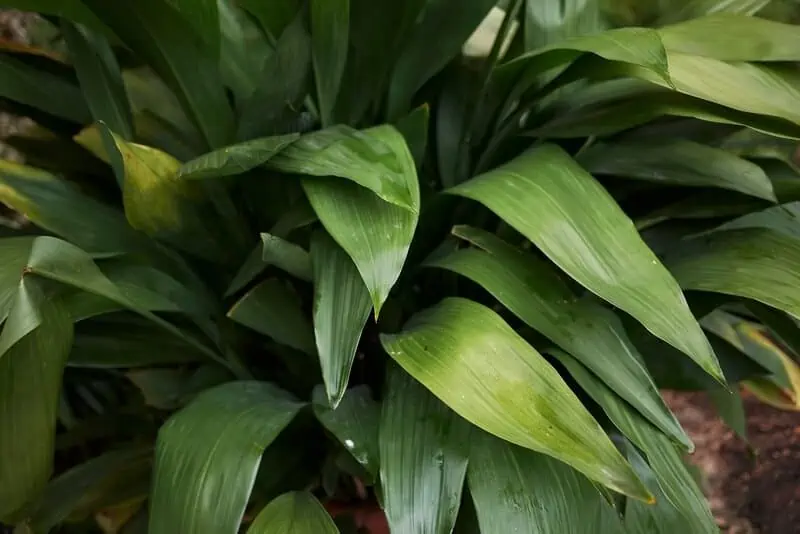
The great thing about Aspidistra is that it’s easy to care for. As always, it starts with well-draining soil. Regular watering is necessary, but the plant can handle light drying between hydration periods.
For lighting, this plant is versatile. It can thrive in any light. It usually has no problem living in chameleon enclosures with limited lighting setups.
28. Boston Fern
The final plant we’re recommending is the Boston fern. This plant is super dense, producing feather-like leaves. While it doesn’t create tendrils like other hanging plants, the sheer number of leaves results in a bushy appearance perfect for hiding.
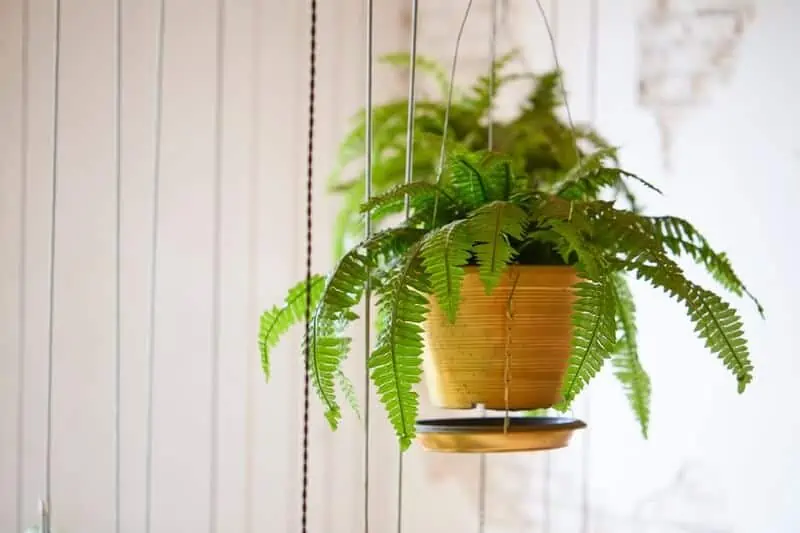
The Boston fern prefers an all-purpose potting mix with peat moss. It should drain well while holding onto some water—these plants like moist soil at all times.
Indirect lighting is best, and you should avoid putting it anywhere near heat or grow lamps.
Best Practices For Chameleon Plants
If you’re not a seasoned gardener, don’t fret. Most plants for chameleons aren’t as hard to care for as you might think! While every cultivar has its own unique quirks and requirements, there are many best practices you can employ to ensure success.
Prepare Your Plants Correctly
While you can sometimes get these plants from reputable reptile dealers, most enthusiasts source them from gardening centers and big-box stores. It’s a cheaper and more accessible alternative. However, remember that those plants aren’t raised for chameleon use!
As a result, they’re often treated with pesticides.
Before you put them into your chameleon’s enclosure, rinse the plants in water to remove as many chemicals as possible.
Use The Right Soil
The first mistake many novices make when trying different plants for chameleons is simply using the wrong soil. Plants often require soil that drains efficiently. If you’re using something highly compacted, it’ll only cause root rot.
Make sure to check any formulas you’re using, too. Some potting mixes contain tiny rocks or fertilizer pellets. Not only can they poison your chameleon, but they can get ingested and cause compaction issues.
Be Careful With Fertilizers
Another thing to remember is that many fertilizers can harm your chameleon. They might use harsh chemicals that inadvertently poison your pet. Organic, animal-safe products do exist.
Please do your due diligence before feeding your plants to ensure they don’t cause any health issues with your reptile.
Mind The Lights
Getting the lighting right is one of the more challenging aspects of keeping plants healthy in a chameleon enclosure. You’re at the whims of your lighting setup.
To truly thrive, plants will often need lights equipped with UV bulbs. Be mindful of the types of lights you use and where you place the plants. Avoid putting your plants directly under the heating lamp. That will only kill them!
Don’t Overdo It
Our last tip is to avoid going overboard with plants. We get it: Having a lush tropical paradise inside your chameleon enclosure looks impressive. But it sometimes cramps the reptile’s lifestyle.
Make sure your lizard has ample room to move around. Avoid overcrowding the habitat and make your chameleon’s comfort and well-being the top priority.
Conclusion
Now that you know the best plants for chameleons, it’s time for you to pick your favorites! Remember, don’t go overboard. As much as they like vegetation, chameleons still need some room in their habitat!
If you have any questions about the plants on this list, let us know. We’re more than happy to help!

